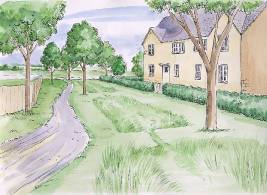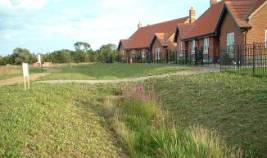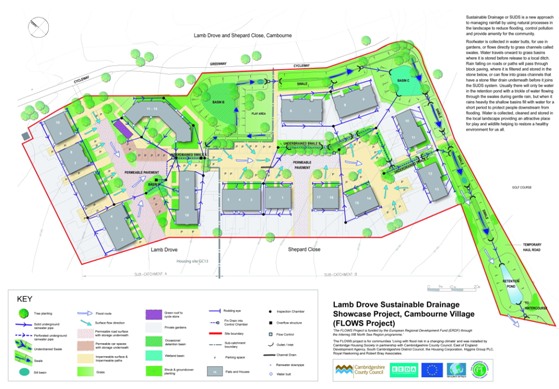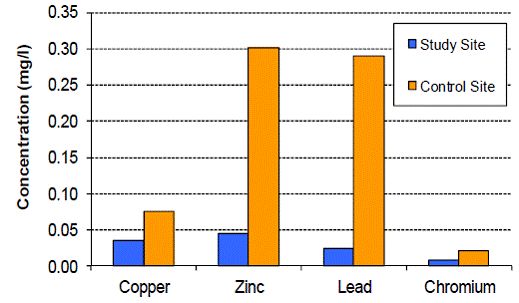Where
Description
Lamb Drove is a residential development of 35 affordable homes (developed and owned by Cambridge Housing Society) on a one hectare site. The aim of the Lamb Drove SuDS scheme was to showcase practical and innovative sustainable water management techniques (incorporating SuDS and property flood resilience and resistance) within new residential developments.
The project intended to demonstrate that SuDS are a viable and attractive alternative to more traditional forms of drainage and to deliver practical solutions for new housing areas.
SuDS used
A range of SuDS components were used to demonstrate different available techniques and the application of management train from prevention to site control and regional control components. The measures include:
-
water butts
-
permeable paving
-
a green roof
-
swales
-
filter strips
-
detention and wetland basins
-
a retention pond
Permeable Paving – The pavements within the residential roads is of permeable construction (see Figures 1 and 2). Gaps between the paving allow water to enter porous storage zones and to filter out pollutants.
 |
 |
|
Figure 1 Permeable paving (Royal Haskoning) |
Figure 2 Permeable paving (Royal Haskoning) |
Green Roof - A small demonstration green sedum roof is included to reduce and treat runoff (see Figures 3 and 4).
 |
 |
|
Figure 3 Green roof on bike shed (Royal Haskoning) |
Figure 4 Green roof on bike shed (Royal Haskoning) |
Swales – Most of the excess water from the site will be fed into a series of shallow open channels, further slowing the flow of water and continuing the water treatment process (see Figures 5 and 6).
 |
 |
|
Figure 5 Swale (artist impression) |
Figure 6 Swale (Royal Haskoning) |
Detention Basins – Sculpted depressions in open spaces help to slow down the runoff rate and store water on a temporary short-term basis during extreme events (see figures 7 and 8).
 |
 |
|
Figure 7 Detention basin (Royal Haskoning) |
Figure 8 Detention basin (Royal Haskoning) |
How it works
The concept of the management train was adopted for the site. The management train uses drainage components in series to improve the water quality and controls the quantity of runoff incrementally by reducing pollution, flow rates and volumes. It mimics as much as possible the natural pattern of drainage prior to development and uses a hierarchy of components within an integrated framework, to manage runoff as close as possible to the source.
Water management was considered from the point at which it falls on land and buildings to the point at which it leaves the site.
At Lamb Drove components and features have been kept simple, natural and visible. The aim is to control the runoff starting as close as possible to its source. The use of source control features within the housing development areas manages most pollution and deals with the day-to-day runoff storage requirements.
Roofwater is collected in water butts, for use in gardens, or flows directly to grass swales or under-drained swales. Rain falling on roads or paths will pass through the permeable block paving, where it is filtered and stored in the permeable layer of crushed rock below, or flows into under-drained swales where water is treated and conveyed. Water then travels downstream through a series of swales, detention basins and wetlands till it reaches a final retention pond. Here it is stored before being released to a local drainage ditch outside the development site.
When the capacity of source control components are exceeded the excess water is safely stored and treated in larger SuDS components integrated within public open space until the flood risk has passed. Such components also contribute to the provision of green space, green infrastructure, visual amenity and promoting wildlife. Throughout the site, blockage free and simple flow control structures as well as overland flow paths were provided to cater for more extreme flood events.
Specific details
The driving force behind the project is the growing pressure for new housing in the UK. Cambridgeshire in particular is a key growth area under the government’s housing strategy, with up to 50,000 new houses planned to be built by 2016. It is also a relatively low-lying county where flooding in river valleys and urban watercourses is a major concern.
The project was part of a European funded programme (FLOWS), which featured 40 projects throughout Germany, the Netherlands, Norway, Sweden and the UK.
Design & construction
Once Lamb Drove had been chosen as the site for the project (in January 2004) it took just over two years to design and then install the system, with residents moving in during spring/early summer of 2006. Royal Haskoning were employed as drainage consultants and used their advice and guidance to help design the SuDS scheme at Lamb Drove.
Project time-scale constraints meant that the design principles and layout of the site were already set and the SuDS had to be built around it.
Figure 9 illustrates the initial SuDS proposals developed for Lamb Drove. It clearly shows the range of SuDS components (permeable paving, swales, detention basin etc) and demonstrates the principles of the management train and source control, detailed above.
The scheme and components that were chosen were derived from the site topography and the pre-development drainage patterns, which ensure two key overland flood routes through the site.
|
|
 |
|
|
|
Figure 9 Initial SuDS proposal (Royal Haskoning) Click on image to enlarge |
|
In order to provide a 1:100 year return period volume with an extra 20% allowance for probable climate change, it became apparent that the peripheral public open space would be required to achieve a reasonable hierarchy of storage. Therefore recreational space in the LAP area within the site and in adjacent greenway and golf course were designed to contain SuDS.
The use of public open spaces, including adjacent, off-site open spaces, provides a viable solution to the problem of accommodating softer landscaped SuDS within housing developments.
In the early stages of the design, it was found that the full attenuation of runoff to a 1:100 year standard, with allowance for climate change, could be accommodated within the site boundary. However, this would have required the use of below ground storage techniques, which are costly and relatively more difficult to manage and maintain.
|
|
 |
|
|
|
Figure 10 Final design of SuDS system (Royal Haskoning) Click on image to enlarge |
|
The adopted final drainage strategy (see Figure 10) shows a number of key changes to the system. This includes the addition of a further detention basin in order to reduce the discharge rate from the site. Undertaking the changes from the initial proposals to the final design had resource implications. Therefore the lessons learnt from this project include the need for confirmation from all the key stakeholders and organisations early in the process and well before the final design if signed-off..
Benefits & achievements
Amongst the many achievements of this project are the following:
-
Successfully incorporated and intergraded a comprehensive SuDS scheme within a residential environment, with positive reactions from both the residents and stakeholders.
-
Demonstrates practical, innovative and cost effective drainage techniques, in both relatively low and high-density developments.
-
Substantial improvement in the biodiversity, ecology and subsequent quality of life at Lamb Drove compared to typical residential developments.
-
The sculptured swales and detention basins have resulted in a visually enhanced and attractive landscape. This provides increased amenity and social value to residents and the local community.
-
The use of SuDS has resulted in an improved quality of water leaving the site compared with traditional piped drainage systems.
-
The estimated cost savings due to SuDS is approximately £11k (around 10%). In addition, each house will have two water butts to collect rainfall from the roof, which can be used for watering gardens and other applications for which rainwater is suitable. Omission of the new storm sewer connection should give some financial benefits (approximately £30/year/household) to the residents as it avoids the annual payment of storm water disposal changes to the sewerage undertaker.
-
The project received a commendation award at the RTPI national planning awards 2006 and has been cited in the PPS25 Practice Guide.
Challenges & lessons learnt
Key lessons that have been learnt from undertaking this project include:
-
Many aspects of SuDS can be installed and maintained at a lower cost compared to more traditional forms of drainage. The most cost-effective SuDS components are likely to be achieved through landform and other treatments within the soft landscaped areas, as the long-term management and maintenance of these components can be effectively incorporated within landscape and wildlife management regimes.
-
Need to keep SuDS simple, as this will reduce maintenance costs and the likelihood of system being well maintained into the future. Also a key advantage of swales and other surface-based SuDS is that problems can be observed and dealt with as they arise.
-
In high density developments, SuDS are likely to rely more heavily on special treatments of hard areas (such as permeable paving or green roofs) with potentially higher costs and different maintenance requirements.
-
SuDS can be incorporated into any terrain as they do not necessarily depend upon infiltration into porous sub-strata. SuDS can equally well be incorporated into the surface landscaping of impervious ground such as clay similar to Lamb Drove.
-
The full attenuation of the 1 in 100 year storm within the development site boundary is both costly and difficult to achieve without the use of multi-use open spaces (e.g. public open space).
-
SuDS should be implemented and integrated from the beginning of the design phase as part of a holistic approach to sustainable development. This should be at Master Planning stage and preferably as part of the Development Plan.
-
High quality specification and quality control in the construction phase is important to reduce whole life costs and future problems.
-
SuDS calls for highly integrated project management and structured communications. It is vital that there is close engagement and cooperation with all parties. Clear performance standards/criteria should be set from the start, and everyone should be aware and sign up to them. The design brief should be clear, precise and simple.
-
Input of specialist SuDS drainage expertise was effective from the FLOWS team but there needs to be wider understanding and expertise amongst other stakeholders.
The key lessons from this project have been gathered together into a Best Practice Guide.
Other issues
Maintenance and adoption - “Softer” measures (e.g. swales and detention basins) will be undertaken by Cambridge Housing Society (general site care) and the Cambridge Wildlife Trust (off-site care). This involves a monthly site visit to undertake grass cutting, litter picking and inlet/outlet inspections between March and November every year.
The permeable paving has not been adopted and maintained by Cambridgeshire County Council. The County Council and the developer have not yet reached the agreement of adopting the roads within Lamb Drove site and roads leading to the site, known as Section 38 agreement. Therefore the permeable pavements have been in operation without suction sweeping since the installation. Cambridge Housing Society have cleaned and manually swept the permeable pavements regularly.
Safety – Initially there were concerns from some parties due to the perceived notion that there would be lots of standing water within the system. However, education about the true nature of SuDS (e.g. that there would only be a small amount of water in them and that this would only be in heavy rainfall events), together with ROSPA (Royal Society for the Prevention of Accidents) undertaking a very successful and transparent safety audit, reassured stakeholders of the lack of risk.
|
|
 |
|
|
|
Figure 11 Interpretation board on site |
|
Education – In order that residents and wider community are aware of the SuDS measures at Lamb Drove they have all been presented with information on the system. In addition a site interpretation board has also been erected on site (see figure 11).
Performance data - Cambridgeshire County Council secured funding for the 3-year monitoring of the system (2008-2011) in order to demonstrate the long term impact of SuDS on both the quantity and quality of water leaving the site as well as environmental and social implications. Royal Haskoning was commissioned to undertake the monitoring. The Monitoring Report can be found from Cambridgeshire County Council web site.
The monitoring project aimed to assess and compare the performance of a range of SuDS components with that of pipe drainage system. It compared SuDS within Lamb Drove site and the pipe drainage within a local control site. The key findings of the monitoring project are:
-
The Lamb Drove site has attenuated surface water flows, significantly reduced peak flows have been observed when compared to the Control Site. Fig. 13 shows the comparison of discharge at the Lamb Drove Site and the Control Site on the 13th and 14th December 2008.
|
|
 |
|
|
Figure 12 Discharge of water in 13 and 14 December 2008 (Royal Haskoning) |
-
SuDS has improved the quality of water discharged from Lamb Drove when compared to the Control Site. Results have shown that Lamb Drove has observed reductions in concentrations of a variety of pollutants and other water quality indicators. Fig. 14 shows the comparison of heavy metal concentrations at Lamb Drove and the Control Site.
|
|
 |
|
|
Figure 13 Comparisons of heavy metal (Royal Haskoning) |
-
Lamb Drove has shown a higher number of species present over the three surveys than the Control Site. The number of species has increased at the Lamb Drove site over the monitoring period from 30 to 34 while it has decreased at the Control Site (34 to 21). Lamb Drove shows more diversity, which is primarily due to the SuDS components and the associated management regime.
-
The permeable pavement infiltration study undertaken by Cranfield University illustrates the robustness of the performance of this feature to limited maintenance. The infiltration capacity of the permeable pavement is able to adequately cope with the highest recorded rainfall intensity at the Study Site. Fig. 15 shows the mean infiltration rate for the permeable pavements at Lamb Drove compared to 1 in 100 and 1 in 50 year return period rainfall intensities.
|
|
 |
|
|
Figure 14 Infiltration rates for permeable pavements at Lamb Drove (Royal Haskoning) |
-
Overall both the capital and the maintenance costs associated with Lamb Drove are lower when compared to costs associated with conventional pipe drainage systems.
Key learning for other local authorities
-
Pre-planning stage discussions with the local authority, regulators (e.g. Environment Agency) and adoption authorities play an important part of the implementation of SuDS within any development
-
Input of specialist SuDS drainage expertise (including ecologists, landscape architects and urban designs who understand requirements of SuDS) is essential to support developers and planners. This input needs to be brought in as early as possible and continue through into construction.
-
The linkages between SuDS and the wider sustainable development agenda should be recognised by the planners, developers and other key organisations -planning for SuDS may well be an important mechanism for unlocking the other desired planning benefits such as better design, green spaces and biodiversity.
-
The importance of including SuDS requirements at an early stage in Development Plans and master planning exercises should be understood by all parties. It is much harder to incorporate SuDS into a pre-designed scheme. SuDS must be designed in from the very start.
-
It is important that local authority development control teams have a good understanding of the aims and implications of SuDS. For Lamb Drove there were three different case officers at different stages of the planning process. This required three repetitions of the briefing and familiarisation process, with some knock-on effects to the timetable. However, it is a tribute to the development control team at South Cambridgeshire District Council that officers remained committed to progressing the project and offered numerous helpful suggestions as the scheme moved forward.
-
More willingness of all parties including local authorities, highway authorities and water companies to understand the overall benefits of SuDS to achieve sustainable development enabling improved adoption of SuDS measures.
-
SuDS needs to be championed at Council/ Company Director level involving the relevant officers and political leaders.
Challenges & lessons learned
-
Maintenance and adoption of SuDS has raised many perceived concerns with client groups, developers and local authorities. To overcome these concerns, a simple checklist of maintenance tasks that can be understood by clients, site managers and implemented by landscape contractors has been written based on the DTI Report SR626 ‘The Operation and Maintenance of Sustainable Drainage Systems (and Associated Costs).
-
The Lamb Drove project has recognised that adoption may involve multiple agencies including residents, housing association, parish councils, local authorities and highway authorities but has been able to work with all parties through successful consultation. Cambridge Housing Society has incorporated maintenance of SuDS into their landscape management regime.
For further information on the project see the Cambridgeshire County Council website
The information on the Lamb Grove project was provided by:
Sass Pledger, Cambridgeshire County Council, Box No: CC1216, 2nd Floor A Wing, Castle Court, Shire Hall, Castle Hill, Cambridge, CB3 0AP



